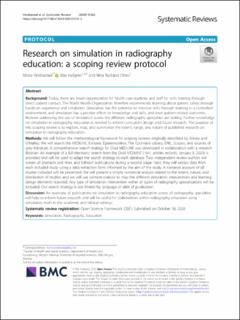| dc.description.abstract | Background
Today, there are fewer opportunities for health care students and staff for skills training through direct patient contact. The World Health Organization therefore recommends learning about patient safety through hands-on experience and simulation. Simulation has the potential to improve skills through training in a controlled environment, and simulation has a positive effect on knowledge and skills, and even patient-related outcomes. Reviews addressing the use of simulation across the different radiography specialties are lacking. Further knowledge on simulation in radiography education is needed to inform curriculum design and future research. The purpose of this scoping review is to explore, map, and summarize the extent, range, and nature of published research on simulation in radiography education.
Methods
We will follow the methodological framework for scoping reviews originally described by Arksey and O’Malley. We will search the MEDLINE, Embase, Epistemonikos, The Cochrane Library, ERIC, Scopus, and sources of grey literature. A comprehensive search strategy for Ovid MEDLINE was developed in collaboration with a research librarian. An example of a full electronic search from the Ovid MEDLINE (1641 articles records, January 9, 2020) is provided and will be used to adapt the search strategy to each database. Two independent review authors will screen all abstracts and titles, and full-text publications during a second stage. Next, they will extract data from each included study using a data extraction form informed by the aim of the study. A narrative account of all studies included will be presented. We will present a simple numerical analysis related to the extent, nature, and distribution of studies, and we will use content analysis to map the different simulation interventions and learning design elements reported. Any type of simulation intervention within all types of radiography specializations will be included. Our search strategy is not limited by language or date of publication.
Discussion
An overview of publications on simulation in radiography education across all radiography specialties will help to inform future research and will be useful for stakeholders within radiography education using simulation, both in the academic and clinical settings. | en_US |

